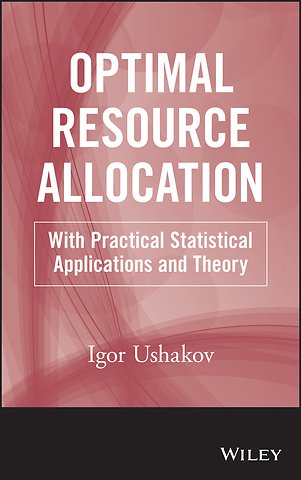Optimal Resource Allocation – With Practical Statistical Applications and Theory
With Practical Statistical Applications and Theory
Samenvatting
A UNIQUE ENGINEERING AND STATISTICAL APPROACH TO OPTIMAL RESOURCE ALLOCATION
Optimal Resource Allocation: With Practical Statistical Applications and Theory features the application of probabilistic and statistical methods used in reliability engineering during the different phases of life cycles of technical systems.
Bridging the gap between reliability engineering and applied mathematics, the book outlines different approaches to optimal resource allocation and various applications of models and algorithms for solving real–world problems. In addition, the fundamental background on optimization theory and various illustrative numerical examples are provided. The book also features:
An overview of various approaches to optimal resource allocation, from classical Lagrange methods to modern algorithms based on ideas of evolution in biology
Numerous exercises and case studies from a variety of areas, including communications, transportation, energy transmission, and counterterrorism protection
The applied methods of optimization with various methods of optimal redundancy problem solutions as well as the numerical examples and statistical methods needed to solve the problems
Practical thoughts, opinions, and judgments on real–world applications of reliability theory and solves practical problems using mathematical models and algorithms
Optimal Resource Allocation is a must–have guide for electrical, mechanical, and reliability engineers dealing with engineering design and optimal reliability problems. In addition, the book is excellent for graduate and PhD–level courses in reliability theory and optimization.
Specificaties
Inhoudsopgave
<p>1 BASIC MATHEMATICAL REDUNDANCY MODELS 1</p>
<p>1.1 Types of Models 2</p>
<p>1.2 Non–repairable Redundant Group with Active Redundant Units 3</p>
<p>1.3 Non–repairable Redundant Group with Standby Redundant Units 7</p>
<p>1.4 Repairable Redundant Group with Active Redundant Units 10</p>
<p>1.5 Repairable Redundant Group with Standby Redundant Units 13</p>
<p>1.6 Multi–level Systems and System Performance Estimation 15</p>
<p>1.7 Brief Review of Other Types of Redundancy 16</p>
<p>1.8 Time Redundancy 24</p>
<p>1.9 Some Additional Optimization Problems 27</p>
<p>Chronological Bibliography of Main Monographs on Reliability Theory (with topics on Optimization) 30</p>
<p>2 FORMULATION OF OPTIMAL REDUNDANCY PROBLEMS 33</p>
<p>2.1 Problem Description 33</p>
<p>2.2 Formulation of the Optimal Redundancy Problem with a Single Restriction 35</p>
<p>2.3 Formulation of Optimal Redundancy Problems with Multiple Constraints 39</p>
<p>2.4 Formulation of Multi–Criteria Optimal Redundancy Problems 43</p>
<p>Chronological Bibliography 45</p>
<p>3 METHOD OF LAGRANGE MULTIPLIERS 48</p>
<p>Chronological Bibliography 55</p>
<p>4 STEEPEST DESCENT METHOD 56</p>
<p>4.1 The Main Idea of SDM 56</p>
<p>4.2 Description of the Algorithm 57</p>
<p>4.3 The Stopping Rule 60</p>
<p>4.5 Approximate Solution 66</p>
<p>Chronological Bibliography 68</p>
<p>5 DYNAMIC PROGRAMMING 69</p>
<p>5.1 Bellman s Algorithm 69</p>
<p>5.2 Kettelle s Algorithm 73</p>
<p>Chronological Bibliography 84</p>
<p>6 UNIVERSAL GENERATING FUNCTIONS 85</p>
<p>6.1 Generating Function 85</p>
<p>6.2 Universal GF (U–function) 87</p>
<p>Chronological Bibliography 94</p>
<p>7 GENETIC ALGORITHMS 96</p>
<p>7.1 Introduction 96</p>
<p>7.2 Structure of Steady–State Genetic Algorithms 100</p>
<p>7.3 Related Techniques 102</p>
<p>Chronological Bibliography 104</p>
<p>8 MONTE CARLO SIMULATION 107</p>
<p>8.1 Introductory Remarks 107</p>
<p>8.2 Formulation of Optimal Redundancy Problems in Statistical Terms 108</p>
<p>8.3 Algorithm for Trajectory Generation 108</p>
<p>8.4 Description of the Idea of the Solution 111</p>
<p>8.5 Inverse Optimization Problem 114</p>
<p>8.6 Direct Optimization Problem 124</p>
<p>Chronological Bibliography 129</p>
<p>9 COMMENTS ON CALCULATION METHODS 130</p>
<p>9.1 Comparison of Methods 130</p>
<p>9.2 Sensitivity Analysis of Optimal Redundancy Solutions 135</p>
<p>10 OPTIMAL REDUNDANCY WITH SEVERAL LIMITING FACTORS 142</p>
<p>10.1 Method of Weighing Costs 142</p>
<p>10.2 Method of Generalized Generating Functions 146</p>
<p>Chronological Bibliography 149</p>
<p>11 OPTIMAL REDUNDANCY IN MULTISTATE SYSTEMS 150</p>
<p>Chronological Bibliography 170</p>
<p>12 CASE STUDIES 172</p>
<p>12.1 Spare Supply System for Worldwide Telecommunication System Globalstar 172</p>
<p>12.2 Optimal Capacity Distribution of Telecommunication Backbone Network Resources 179</p>
<p>12.3 Optimal Spare Allocation for Mobile Repair Station 183</p>
<p>Chronological Bibliography 190</p>
<p>13 COUNTER–TERRORISM: PROTECTION RESOURCES ALLOCATION 191</p>
<p>13.1 Introduction 191</p>
<p>13.2 Written Description of the Problem 192</p>
<p>13.3 Evaluation of Expected Loss 195</p>
<p>13.4 Algorithm of Resource Allocation 197</p>
<p>13.5 Branching System Protection 201</p>
<p>13.6 Fictional Case Study 210</p>
<p>13.7 Measures of Defense, Their Effectiveness, and Related Expenses 217</p>
<p>13.8 Antiterrorism Resource Allocation under Fuzzy Subjective Estimates 223</p>
<p>13.9 Conclusion 232</p>
<p>Chronological Bibliography 232</p>
<p>About the author 235</p>

